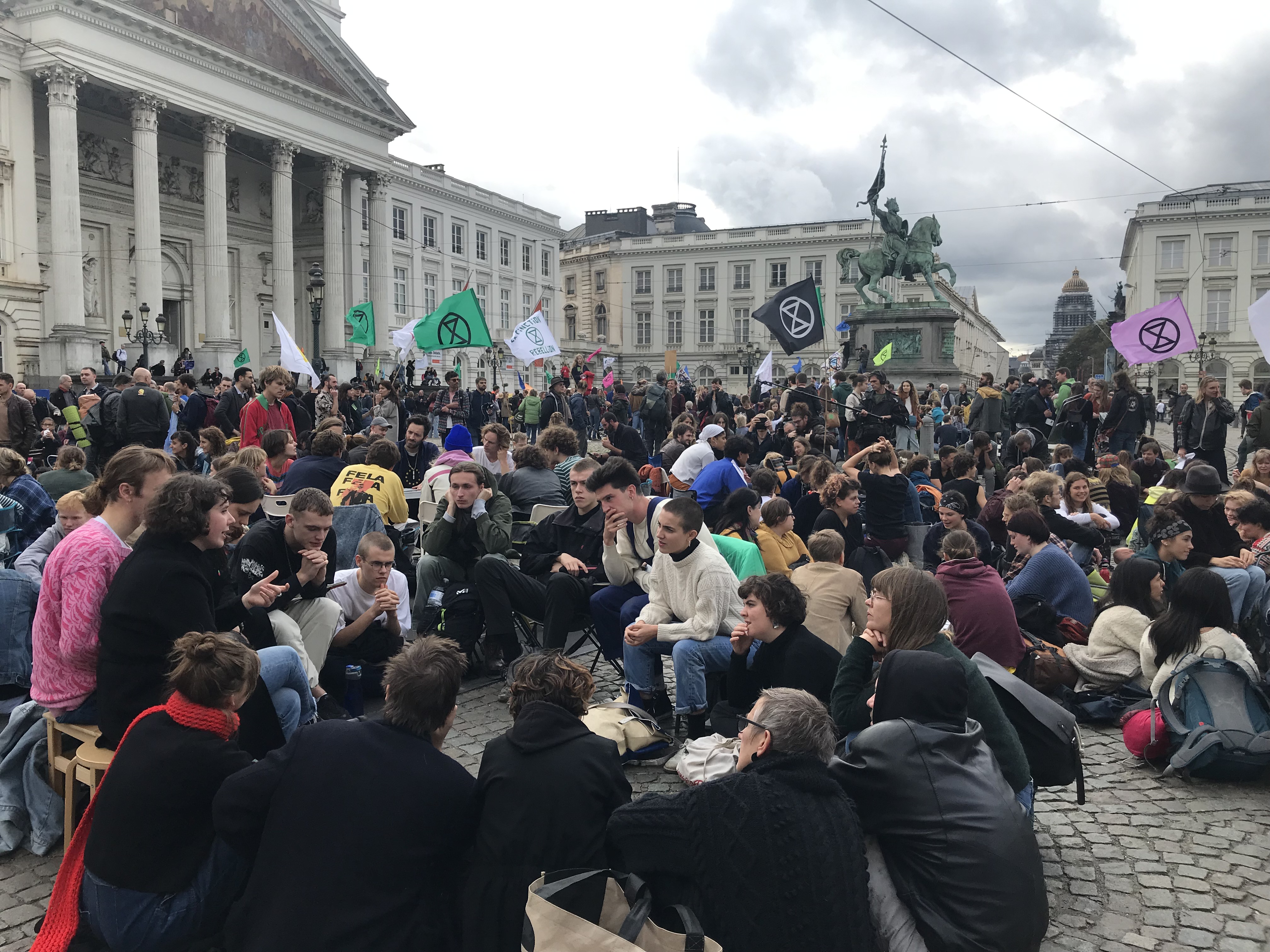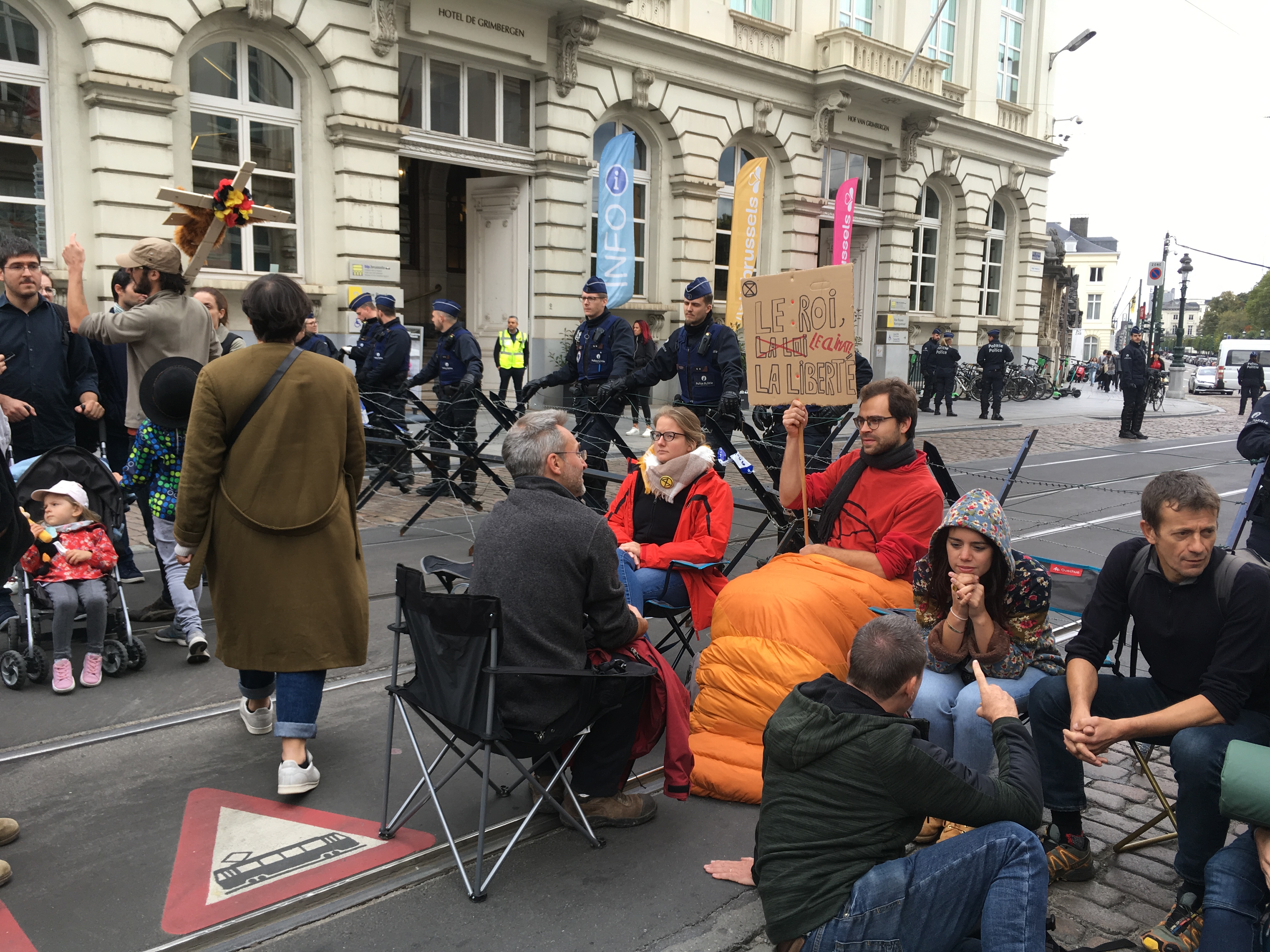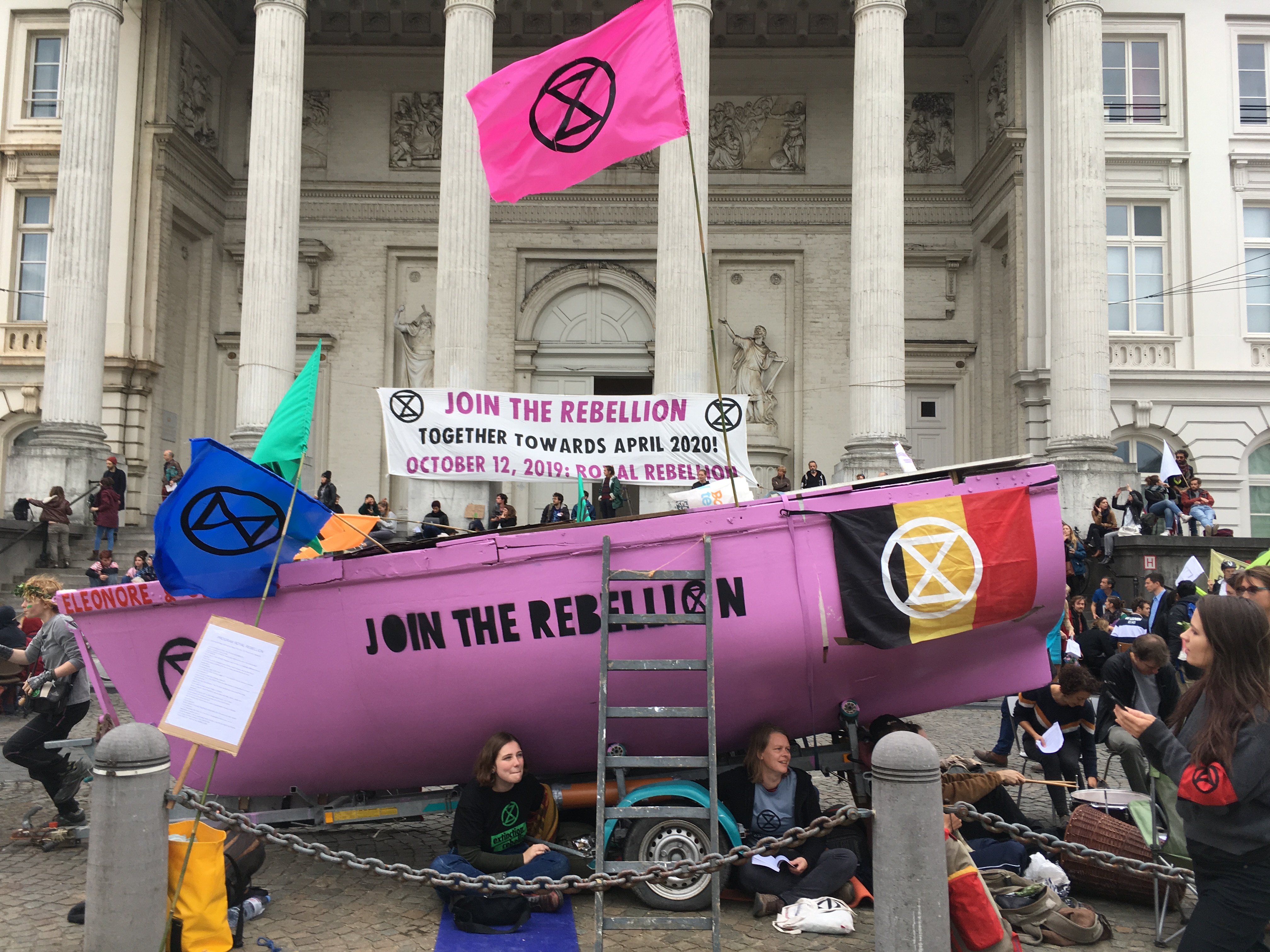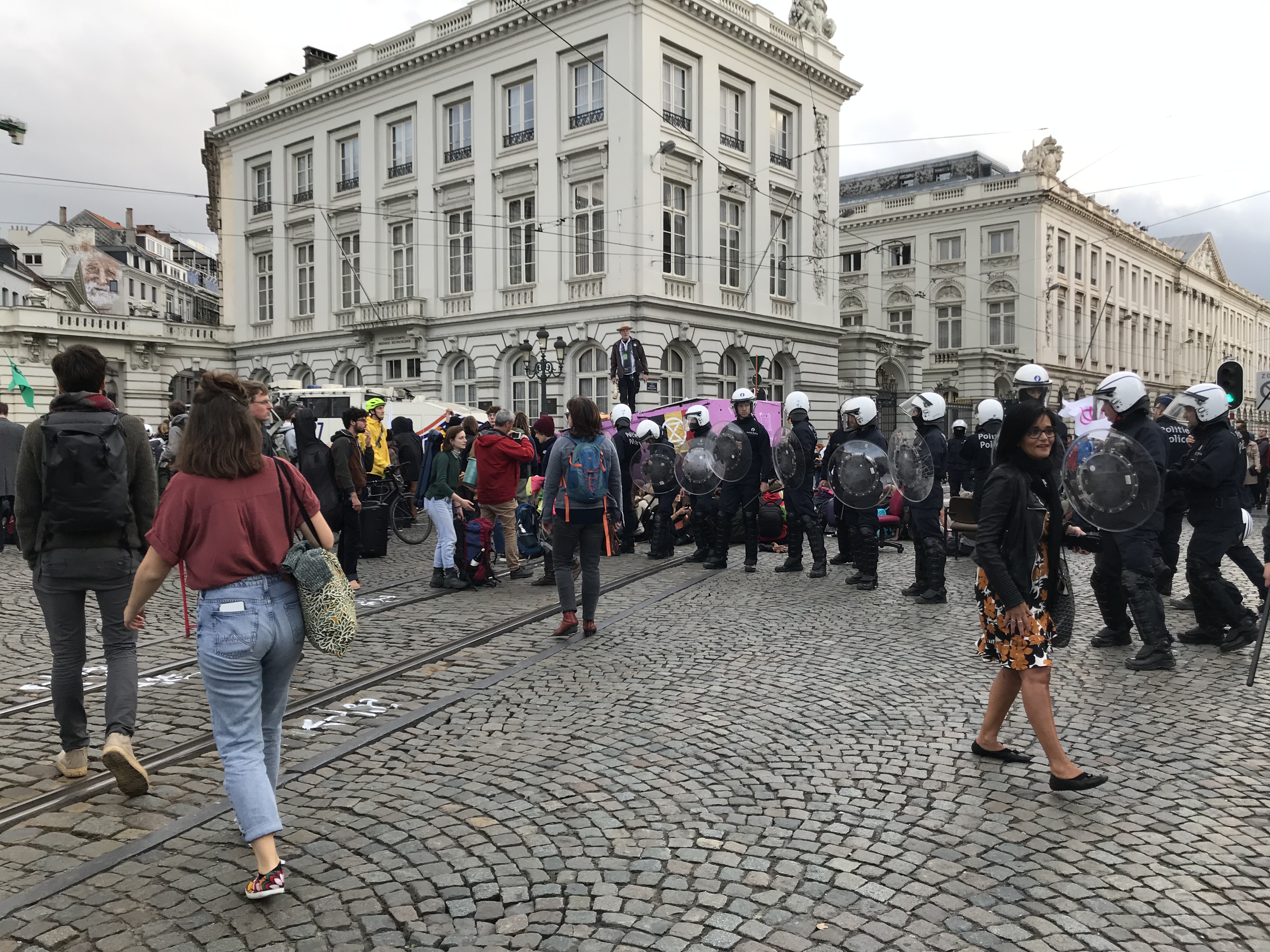
Extinction Rebellion : A well-planned revolt
Published on
Translation by:
Gabriel ButtigiegAfter a shattering debut in England, the Extinction Rebellion movement has been exported to the four corners of the world to defend ecological interests and force governments to act in a concrete way. We followed the meticulous organisation in their first major action in Belgium, the Royal Rebellion.
On a cold October evening in Brussels, about 30 people gathered at BOOM , an associative café in the city centre. After a round of craft beers, Lino and Sarah , two members of the Brussels network of Extinction Rebellion (XR) led a discussion. This was the first time that Sarah, a 26-year-old physics doctoral student, led an evening dedicated to civil disobedience. She came to prepare the aspiring rebels for the Royal Rebellion on thr 12th of October in Brussels. The mission was to enter the gardens of the King to hold popular assemblies on major climate and societal challenges. The ultimate hope was to urge the King to declare a state of climate and ecological emergency at the national level.
Extinction Rebellion is a non-political and non-violent civil disobedience movement that fights ecological collapse and the climate and social crisis. It began in 2018 in the United Kingdom, but quickly became renown internationally, while the number of local groups in different countries increased. The rebels are united by three main demands—that governments declare a climate and ecological state of emergency, that they take immediate action to achieve carbon neutrality by 2025, and halt the loss of biodiversity and that they set up popular assemblies to debate environmental issues and social equality.
From 7th to the 20th of October, the group held a worldwide rebellion to get concrete action from different governments. In Paris, hundreds of climate activists took over the Place du Châtelet for several days. In London on the 3rd of October they sprayed the Ministry of Finance with fake blood with the spear of a fire truck. On Saturday, the 12th of October, it was Belgium's turn to protest.

Rebels everywhere
Who can join the movement? Everyone. "There are also people with an activist background who have organised this sort of things, as well as people who are new to it," says Sarah. In Belgium, the movement has more than 2000 members. The XR organisation is decentralised. Each country or city can set up its own branch, provided that it respects the rebels' charter and their operation models, strictly non-violent.
"We want to give the image of people who continue to debate even when the police intervene"
In the French version of their website, we read that "Using a strategy and non-violent tactics [is] the most effective way to bring about change." Indeed, Lino and Sarah explain that, according to Erica Chenoweth's studies, to provoke a change, at least 3.5% of the population must be mobilised—and to achieve this, it is important to keep public opinion on its side. On the day of the mobilisation, one of the facilitators insisted, "If the police come to arrest you, stay calm. We want to give the image of people who continue to debate even when the police intervene. "
The actions of Extinction Rebellion, although different in their forms, follow a similar strategy. The participants gather in a symbolic and strategic place, whether private or public, with a desire to occupy the space so as to attract the attention of passers-by. The goal is to stay as long as possible, before the quasi-systematic intervention of the police and the arrest of some of the rebels.
Detentions are also considered as an important tool of disobedience that brings legitimacy and visibility to actions. Roger Hallam, co-founder of the movement, explains to a reporter from the Guardian that "If people are ready to lose their freedom [for the environmental cause], then governments will have no choice but to pay attention to our demands. "
How far does non-violence go?
Actions are always announced in advance in a transparent manner. On one hand, it allows them to deploy massive communication strategies and tries to mobilise as many people as possible. On the other hand, XR claims it doesn't want to hide. Dialogue is always maintained with the authorities before, during and after the action. In the case of the Royal Rebellion, an open letter was sent to the King upstream and the police had been warned.

Standing near the bar at BOOM, with a beer in hand, Sarah explains how the movement identifies with iconic characters of nonviolent civil disobedience, such as Gandhi , Rosa Parks or Martin Luther King .
The evening begins with a scenario game on the theme of non-violence. It must allow participants to put themselves in different situations and to gauge what is violent and what is not. Is it violent to shout at a police officer? To prevent factory machinery that participates in deforestation from working? Opinions diverge and discussions are animated. As the few damages of the Italie 2 shopping centre in Paris showed after the blocking of the 5th of October, the definitions of non-violence are sometimes unclear.
Soup and camping chairs
On Saturday, the organisers hoped to occupy the gardens for 24 hours. Participants were told to bring warm clothing, containers and vegetables to prepare soup for all rebels. The Royal Rebellion began at 2pm. The police were aware of the action and they tried to block access to the royal palace quickly.
As the Royal Gardens are in a neutral zone, prohibited from demonstrations, the participants were warned that the risk of arrest was high. The role play allowed everyone to identify their affinity group. Composed of six people, it was the point of reference during the different phases of the action.
"To resist passively is not wrong"
They ended the meeting with a legal briefing to try to address the concerns of the rebel aspirants. Extinction Rebellion has lawyers in its group, which allows them to have relative knowledge of the police and judicial systems. They describe the types of arrests they can expect during the action. In the case of sanctions, they plan to organise crowdfunding campaigns to pay for the fines, and to mobilise lawyers to organise a common defense to possible prosecution. For absentees, fact sheets are available on their various networks.
Extinction Rebellion also organises full days of civil disobedience training. Sarah explains, "There are exercises on more specific questions like how to react when someone is arrested. The potato bag technique—to make yourself a dead weight so that it mobilises more people, and so it takes more time. Because resisting passively isn't wrong. There are also exercises on de-escalation strategies, and more in depth discussions around non-violence."
Before leaving, the floor is left to the aspiring protestors. Some are worried about coming with their children, others are wondering about the actual course of an arrest. "What if I don't have a European nationality?" In this case, Lino advises them not to take risks. An arrest, even an administrative arrest, could lead to difficulties in the process of obtaining or renewing the residence permit.
While arrests are an integral part of the movement's strategy, not all are equal in the face of police intervention. "We want to be as inclusive as possible and that the maximum of people join the movement. So we have discussions about inclusivity, intersectionality, decolonisation, and so on. But it is true that it is not necessarily obvious, and that there are many green demonstrators who are white and educated. But then there is also the idea that we use our privilege, such as having free time or not having problems if we get arrested to protest," said Sarah.
At the heart of the royal party
Half an hour before the start of the action, all access to the palace and gardens is blocked. Activists wait for last-minute instructions via a Telegram conversation. Discouraged by the dams, affinity groups finally head for la Place Royale, just a few steps away from the gardens. On site, a good-natured atmosphere was in order. People sat on the floor or on their chairs and wondered about the rest of the day would go.
Activities taking place, ranged from a silkscreen workshop on old clothes to the hanging of flags and banners everywhere in the square. The cameras of the journalists present were focused on a local group who came with a pink boat for the occasion.

The rebels came from all over Belgium to appeal to the King. Marie, 34, has travelled more than 100 kilometers with her young daughter and companion "I do not feel like I'm here as a militant or an activist, but rather as a citizen who feels revolted by the fact that the public authorities do not take more responsibility or drastic decisions to stop the course of global warming. And I still have enough confidence that politics is for something. That's why I'm here today. It's important to try as much as you can to put some form of pressure on, or to express our dissatisfaction as much as we can. "
Popular assemblies, in English, Dutch and French, are formed. The goal is to sit in a circle to discuss topics related to social and environmental justice. A group discusses how to live in the future without cheap, abundant energy. The facilitator explains that achieving carbon neutrality will require cutting national electricity consumption by a sixth. Innovative or consensus-building ideas are harvested by the facilitators. So that the talking space remains effective and inclusive, a system of signs is set up.
Throughout the afternoon, the facilitator remembers the instructions on the attitude to take in case of confrontation with the police. We must stick to: "I have nothing to declare." While trying to engage in conversation on neutral subjects so as to not encourage hostility with the police. Protesters are encouraged to put the lawyer's reference number on their arm, just in case.
The party is over
At 3pm, the first arrests began. Some rebels managed to break into the gardens in front of the palace. The policemen took them and handcuffed them as soon as they jumped over the fence. A rumour began to spread that a hundred people were arrested and taken to the station (50 according to the XR's press release the next day, ed). People are reassured that here, out of the neutral zone, things are calm. The people's assemblies continue and everyone expected to stay until the night. At least.

But by the late afternoon, there was a twist in the plot. The police multiplied after protesters refused to get away from the rails of the tram. The operation was led by the City of Brussels' Commissioner, Pierre Vandersmissen. After surrounding some of the protesters, the police officers issued a final warning to the only popular assembly that still resisted. "Well, still not? We'll start then." The jets of water from the pumper are set in motion, along with the officers led by their conductor. A few metres away, a group of protesters received the first spray of pepper on their face. Groups formed in every corner in order to help those that didn't manage to avoid the unjustified use of sprays or sticks. Some of them were minors who haven't managed to avoid sprays or batons, whose use is unjustified. The protesters were either already neutralised or were peacefully waiting to be arrested.
In total, more than 400 rebels were arrested. All were released during the night from Saturday to Sunday. The Belgian media and the protesters largely relayed the police violence that followed the famous "We'll start then". Many photos or videos showed sometimes disproportionate reactions from the police.
In a press release, a spokesman of the movement expressed his disappointment at the brutality of some police officers. However, he asserted that "Extinction Rebellion Belgium remains determined. We will continue to go into action/rally and grow until the Belgian state responds to our demands."
So that protesters don't feel discouraged, local groups enter the "regenerative" phase—to create a movement made up of resilient individuals of, Extinction Rebellion "human, benevolent and resilient" culture. In other words, activists are encouraged to meet and help each other even after the action. On an emotional level, debriefings are organised by local groups so that everyone discusses what they understand about the action and how it made them feel. On a practical level, people who received a communal administrative sanction or wish to lodge a complaint are supported by dedicated working groups. And since the organisation, as well-planned as it can be, can always be improved, the activists are asked to fill a satisfaction form.
Cover photo: Royal Rebellion on Saturday, 12th October in Brussels © Hélène Seynaeve
Read also: The day I understood the addictive nature of protests
Translated from Extinction Rebellion : une révolte bien ficelée



